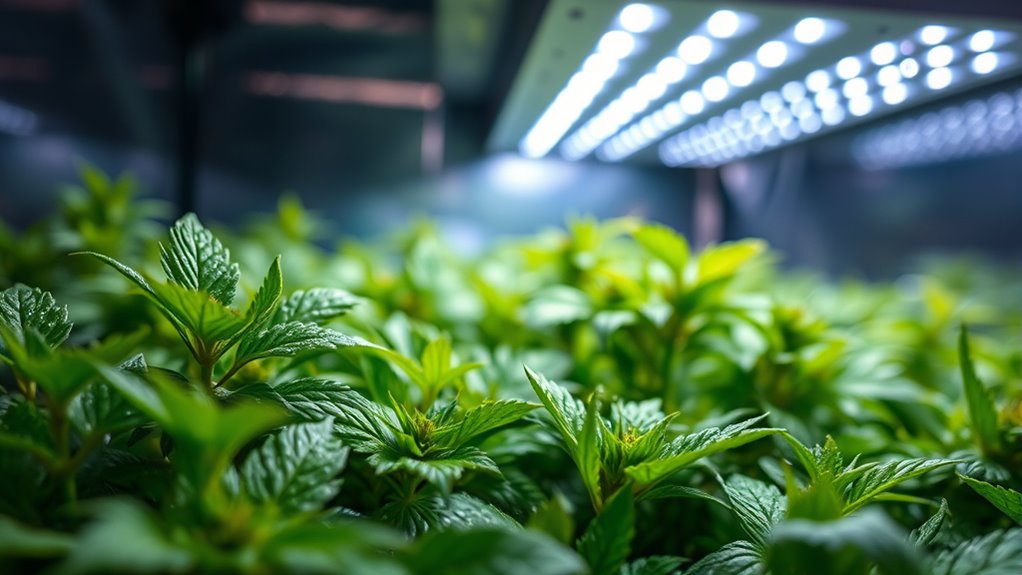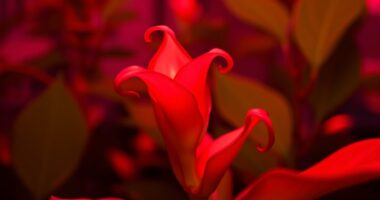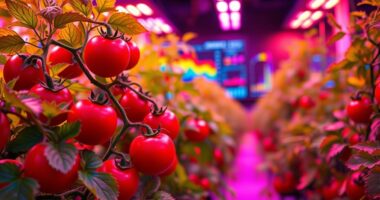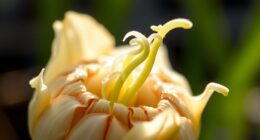PAR (Photosynthetically Active Radiation) is the spectrum plants use for photosynthesis, critical for healthy growth. PPF (Photosynthetic Photon Flux) measures how much light your fixture emits within this spectrum, helping you compare overall light output. PPFD (Photosynthetic Photon Flux Density) shows how much light reaches your plants’ surface, affecting growth and yields. Understanding these acronyms helps you choose and optimize your grow lights effectively. To master their relationship, keep exploring these essential lighting terms.
Key Takeaways
- PAR measures the spectrum of light usable for photosynthesis, focusing on plant growth efficiency.
- PPF quantifies the total photons emitted within the photosynthetically active spectrum by a light fixture.
- PPFD indicates the light intensity at the plant canopy, affecting photosynthesis and growth rates.
- Understanding these metrics helps select and optimize grow lights for different plant stages and space sizes.
- Spectrum data reveals light quality across wavelengths, crucial for promoting healthy vegetative and flowering development.
What Is PAR and Why Is It Important?
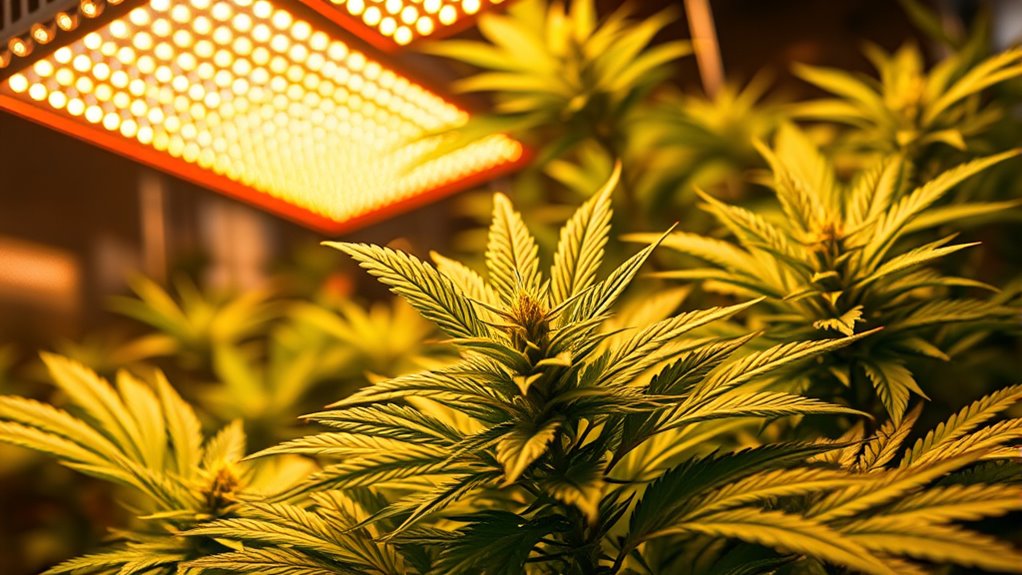
Have you ever wondered what makes certain lighting setups work so well for plants or photography? It all comes down to PAR, which stands for Photosynthetically Active Radiation. This measure focuses on the part of the light spectrum that plant photosynthesis needs to thrive. When a light source provides the right PAR levels, it ensures your plants receive ideal energy for growth. PAR helps you understand how effectively a light delivers usable wavelengths to support photosynthesis. Without considering PAR, even powerful lights may not promote healthy growth if they don’t emit the correct light spectrum. Knowing what PAR is allows you to choose lighting that maximizes plant development and helps you achieve better yields or stunning images. Proper lighting with optimal PAR levels can also be crucial for climate control in indoor growing environments, ensuring stable and healthy plant development.
Understanding PPF: The Measure of Light Output
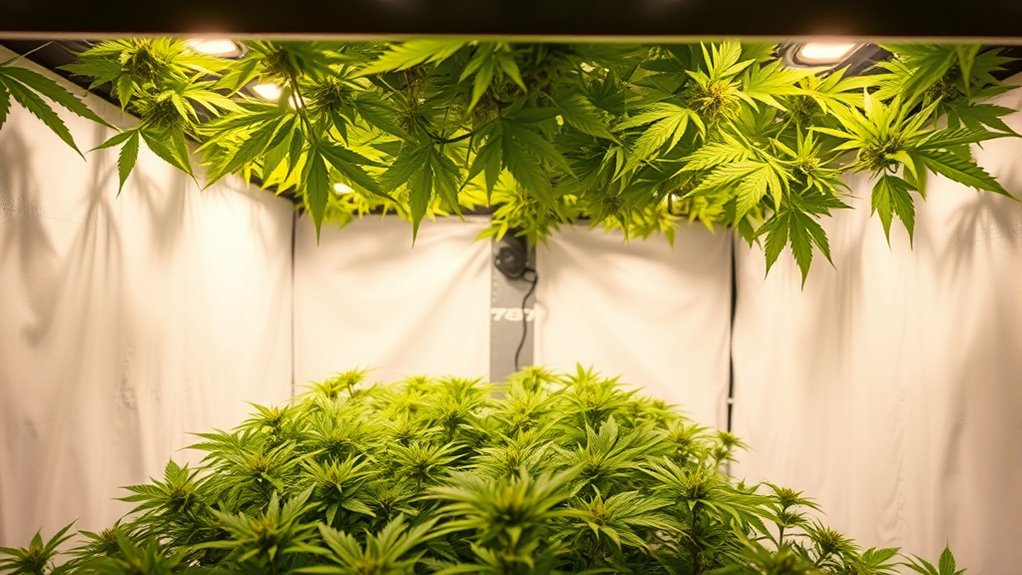
Ever wonder how you can compare the brightness of different grow lights or fixtures? That’s where PPF, or Photosynthetic Photon Flux, comes in. PPF measures the total amount of light emitted by a fixture, helping you gauge its overall output. This measurement allows you to assess light uniformity across your grow space and choose fixtures that deliver consistent coverage. Keep in mind, higher PPF doesn’t always mean better; consider how the light spreads and its color temperature for *ideal* plant health. For example, a fixture with a balanced PPF and proper light distribution promotes even growth. Additionally, understanding PPF helps you match your light setup with your grow area’s size and your plants’ needs. It’s a key step in *maximizing* your lighting strategy effectively. Moreover, considering the light spectrum emitted by your fixtures can further optimize photosynthesis and plant development.
PPFD Explained: Light Intensity for Plants
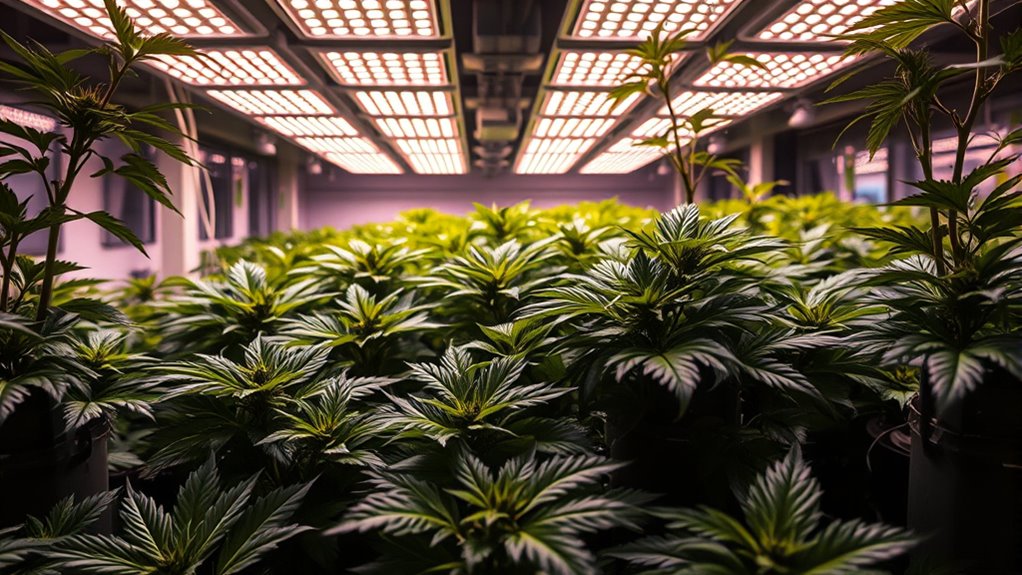
PPFD measures the light intensity your plants receive, directly affecting their growth. Understanding how to gauge light levels helps you optimize conditions for healthy development. Knowing the ideal PPFD range guarantees your plants get the right amount of light without stress or stretch. Additionally, utilizing performance cookies can help you analyze how different light levels impact plant growth and make data-driven adjustments.
Measuring Light Levels
Measuring light levels accurately is vital for guaranteeing your plants receive the right amount of illumination they need to thrive. Proper measurement helps you optimize the light spectrum and photoperiod duration, both essential for healthy growth. To do this effectively, use a PAR meter or quantum sensor to gauge PPFD at plant canopy level. Be sure to take readings at different points to account for uneven light distribution. Remember, light spectrum influences how plants perceive intensity, so consider the quality of light alongside quantity. Additionally, monitor how the light intensity changes throughout the photoperiod to prevent over- or under-lighting. Regularly measuring light levels guarantees your setup remains ideal, promoting vigorous growth and maximum yields.
- Understand the importance of the light spectrum in measurements
- Use reliable tools like PAR meters or quantum sensors
- Track changes in light intensity over the photoperiod
Impact on Plant Growth
Have you ever wondered how light intensity directly influences plant growth? Higher PPFD levels boost photosynthesis efficiency, allowing your plants to produce more energy. When light penetration is strong, it reaches deeper into the canopy, ensuring lower leaves also receive adequate light. This improved light distribution promotes uniform growth and healthier plants overall. Insufficient light intensity can slow down photosynthesis, leading to weak stems, poor flowering, or reduced yields. Conversely, too much light may cause stress or damage, so understanding how PPFD affects light penetration helps you optimize your setup. By maintaining appropriate light levels, you support efficient energy conversion, which translates to vigorous growth, better flower development, and higher crop quality. Proper light management is essential for maximizing your plants’ potential.
Optimal PPFD Range
Ever wonder what the ideal light intensity is for healthy plant growth? The perfect PPFD range varies depending on your plant type and growth stage. Generally, most plants thrive within 200-600 µmol/m²/s during the vegetative stage and 600-900 µmol/m²/s during flowering. Staying within this range ensures they get enough light without risking damage or energy waste. Keep in mind, light color influences how plants perceive PPFD, affecting growth quality. Additionally, maintaining an optimum PPFD range helps improve power efficiency, saving energy and reducing costs. Proper light management is essential for achieving optimal plant health and yield.
- Adjust your light setup to match your plant’s specific needs
- Use light with the right color spectrum for better absorption
- Maximize power efficiency by avoiding over- or under-lighting
Comparing PAR, PPF, and PPFD: How They Work Together
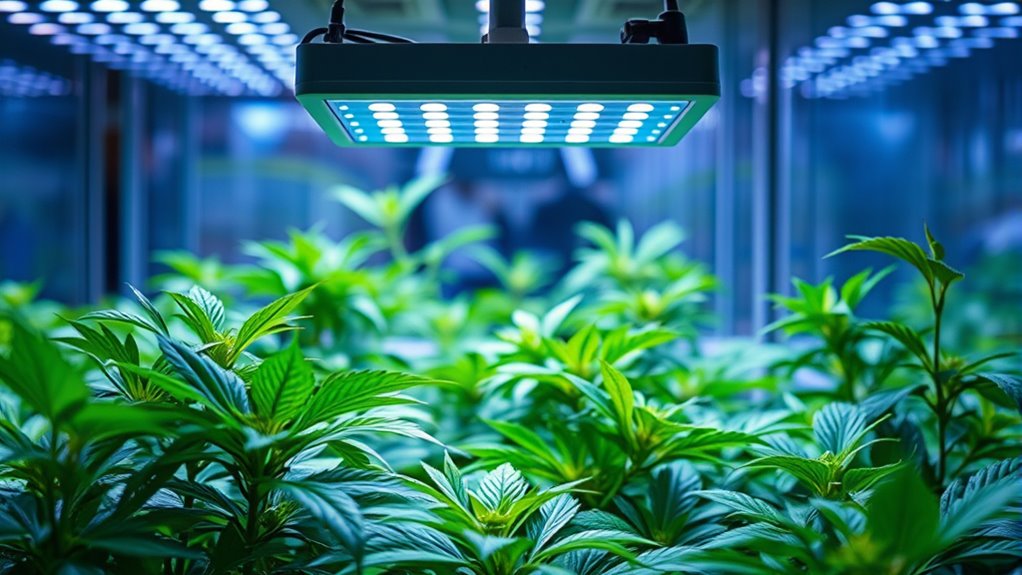
Understanding how PAR, PPF, and PPFD relate to each other is essential for evaluating grow lights effectively. PAR defines the light spectrum that plants use for photosynthesis, guaranteeing you’re providing the right wavelengths. PPF measures the total light output within this spectrum, indicating how much usable light your light source emits. PPFD then measures the light intensity that reaches your plants per square meter, helping you assess if your plants receive enough light for ideal growth. Together, these metrics allow you to compare grow lights based on their energy efficiency and how well they deliver usable light. By understanding their relationship, you can choose a lighting setup that maximizes plant health without wasting energy. This holistic view ensures your grow operation is both effective and cost-efficient.
How to Read Grow Light Specifications
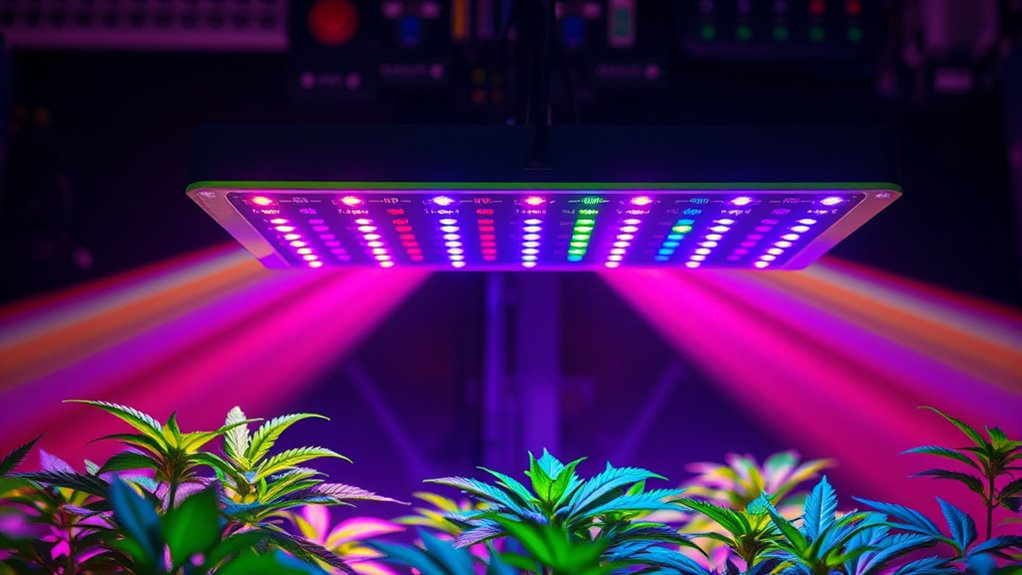
To make the most of your grow lights, you need to know how to read their specifications. This involves understanding light labels, interpreting spectral data, and comparing key metrics. Mastering these points helps you choose the right lighting for healthy, thriving plants. For those interested in optimizing plant growth, understanding the light spectrum and how different wavelengths affect plant development is especially crucial.
Understanding Light Labels
When you look at grow light labels, it’s important to know what the specifications mean so you can choose the right light for your plants. Focus on key details like the light spectrum, which indicates the wavelengths emitted, and energy efficiency, showing how well the light converts electricity into usable light. Understanding these labels helps you compare options effectively. Additionally, consider the color temperature as it can influence plant growth and overall ambiance. Here are some essential points to take into account:
- Light spectrum details reveal if the light is tailored for vegetative growth or flowering.
- Power consumption indicates energy efficiency and operating costs.
- Lumens and PPFD show the intensity and how much light reaches your plants.
Knowing how to interpret these specs ensures you select a grow light that maximizes plant growth while saving energy.
Interpreting Spectral Data
Have you ever wondered what the spectral data on grow light labels really tells you about how your plants will thrive? Spectral distribution shows how much light a fixture emits across different wavelengths, revealing the light quality your plants receive. Look for charts or graphs that display the intensity of various colors within the spectrum. A balanced spectral distribution includes both blue and red wavelengths, essential for healthy growth and flowering. Understanding this data helps you assess whether a light provides the right spectrum for your plants’ needs. Instead of just focusing on wattage or PPF, paying attention to spectral distribution ensures you’re choosing a light that promotes ideal photosynthesis and growth. Recognizing the importance of spectral data and how it influences plant health can significantly improve your grow results. In short, interpreting spectral data helps you select grow lights that deliver the best light quality for your garden.
Comparing Lighting Metrics
Understanding how to compare grow light specifications is essential for choosing the right fixture for your plants. Focus on key metrics like light uniformity and fixture efficiency to make informed decisions. Light uniformity guarantees your plants receive consistent light across the canopy, reducing weak spots. Fixture efficiency indicates how well the light converts electricity into usable light, affecting your energy costs. When comparing options, consider:
- PPFD distribution to assess how evenly light spreads over your grow area
- Lumens vs. PAR output to understand brightness versus usable plant light
- Efficiency ratings to evaluate energy consumption relative to light output
Additionally, understanding the importance of indoor air quality can influence your overall grow environment, impacting plant health and yield.
The Role of Light Spectrum in Plant Growth
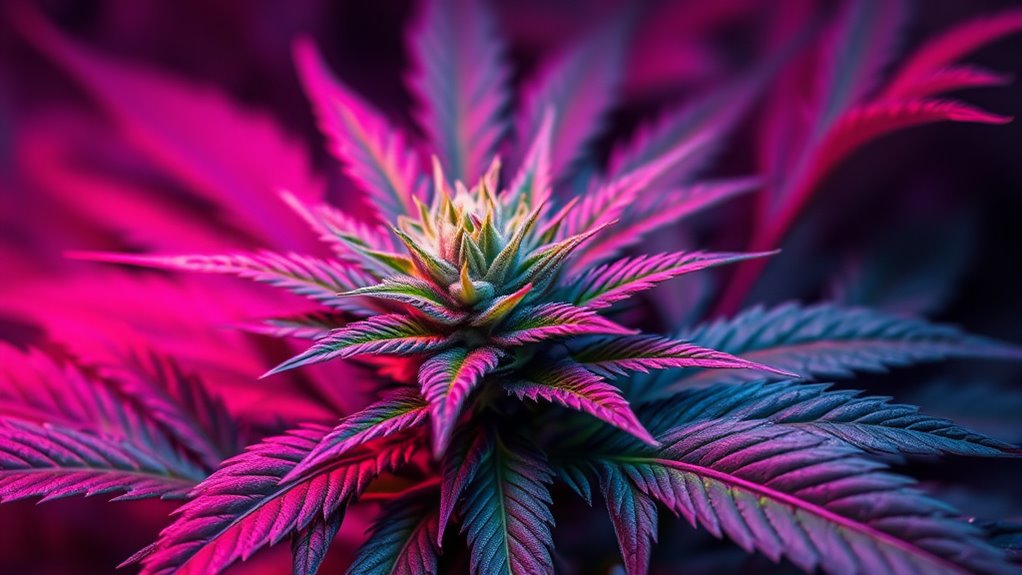
The light spectrum plays an essential role in plant growth because different wavelengths influence various developmental processes. You’ll find that the spectrum’s blue and red wavelengths are especially important because they directly affect plant chlorophyll, which is fundamental for photosynthesis. Blue light promotes vegetative growth, encouraging healthy leaves and stems, while red light supports flowering and fruiting stages. By providing the right balance of these wavelengths, you help optimize your plants’ growth and development. The spectrum also impacts other processes like seed germination and phototropism. Understanding how different parts of the light spectrum influence plant behavior allows you to tailor your lighting setup for healthier, more productive plants. Additionally, light spectrum management enables growers to manipulate plant responses for specific growth outcomes. In short, the right spectrum is essential for achieving your gardening goals.
Tips for Choosing the Right Lighting for Your Plants
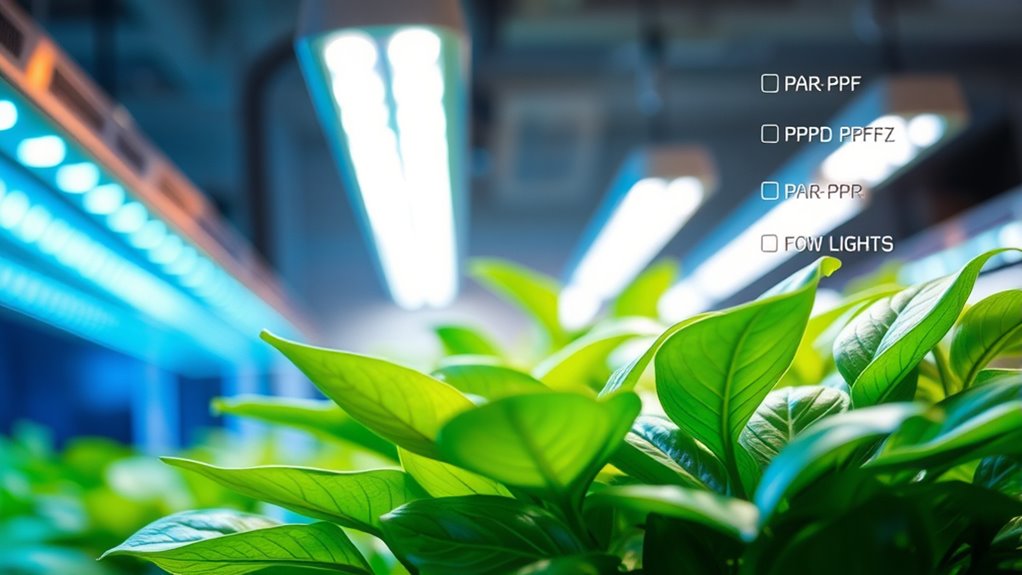
Choosing the right lighting for your plants starts with understanding their specific needs and matching them to the appropriate light sources. Consider the light color, as different wavelengths promote various growth stages, and opt for energy-efficient options to conserve on electricity. Properly adjusting the pressure settings of your lighting system can also optimize light distribution and intensity for healthier plant growth.
To make the best choice, keep these tips in mind:
- Match light spectrum and color to your plant’s growth phase.
- Prioritize energy-efficient lighting to reduce costs and environmental impact.
- Check light output levels like PAR, PPF, and PPFD to ensure your plants receive adequate light intensity.
Common Mistakes When Evaluating Grow Lights
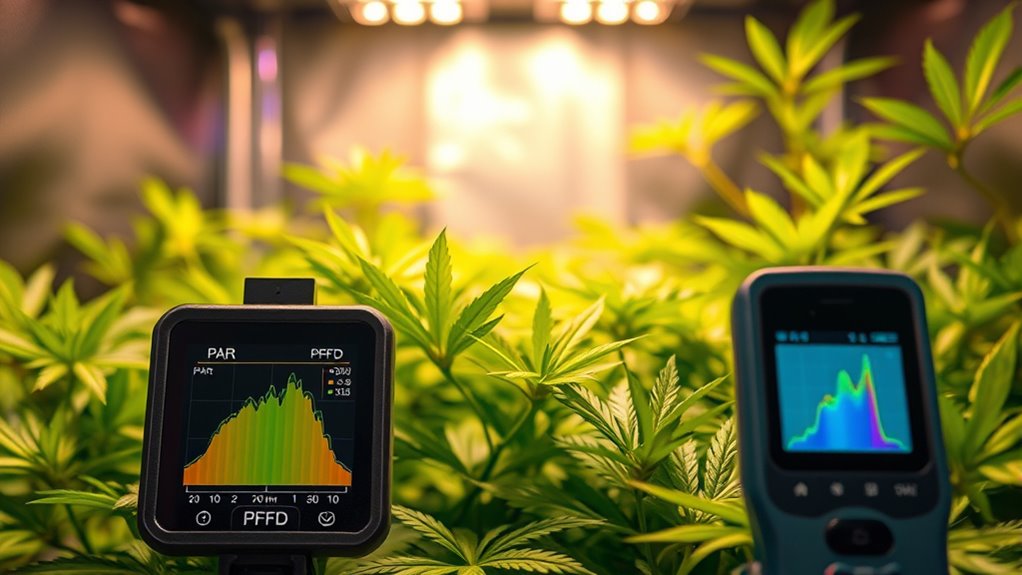
Many growers make costly mistakes when evaluating grow lights, often because they focus solely on single specifications like wattage or brightness without considering how well the light matches their plants’ specific needs. A common error is ignoring advances in lighting technology, which can profoundly impact plant growth and energy efficiency. Relying only on raw wattage can lead to overspending on inefficient lights that waste energy or underperform. Instead, you should consider the efficiency of the light source, such as LED technology, which offers higher energy efficiency and better light distribution. Failing to evaluate the light’s spectrum and PAR output can also hinder growth. To avoid these mistakes, look at the full picture: technology, efficiency, and how well the light’s output aligns with your plants’ requirements.
Frequently Asked Questions
How Does Light Distance Affect PPFD Measurements?
You might notice that as you adjust your light distance, the PPFD measurements change considerably. When you move the light closer, the light intensity increases, giving higher PPFD readings. Conversely, increasing the distance reduces the light intensity and lowers PPFD. This distance impact is vital because maintaining the right light distance guarantees your plants receive ideal light without causing stress or stretch, maximizing growth and yield.
Can Different Plant Species Require Different PAR Levels?
You might think one size fits all, but different plant species have unique needs—it’s a case of species-specific lighting. Each plant’s adaptation determines the ideal PAR levels for healthy growth. You should tailor your lighting setup, adjusting levels based on the species you’re growing. Ignoring these differences can stunt growth or cause stress, so pay attention to your plant’s cues and provide the right light intensity for their specific needs.
What Are the Best Tools to Measure PPFD Accurately?
To measure PPFD accurately, you should use a light meter with a quantum sensor. This specialized tool detects the number of photons in the 400-700 nm range, providing precise readings of light intensity. Make certain the sensor is positioned correctly within your grow space and calibrated regularly. Using a quality quantum sensor ensures you get reliable data, helping you optimize your lighting for healthy plant growth.
How Do Seasonal Changes Influence Grow Light Needs?
Oh, how clever Mother Nature is—changing her light show with the seasons! You’ll need more grow light indoors during winter’s short, cloudy days, while outdoor plants get ample sunlight in summer. Seasonal light variation means adjusting your indoor lighting to mimic natural cycles, ensuring your plants thrive year-round. So, whether indoors or outdoors, stay flexible; nature’s dance demands it, and your plants will thank you for the effort.
Are LED Grow Lights More Efficient Than Traditional Lighting Options?
You’ll find LED grow lights more efficient than traditional lighting options. Their LED efficiency means they use less energy while delivering the same or even better light quality for your plants. Unlike traditional lighting, LEDs produce less heat, which helps you save on cooling costs and reduces light waste. Overall, choosing LEDs can improve your grow’s energy efficiency, making them a smarter, more cost-effective choice for sustained growth.
Conclusion
Now that you know the basics of PAR, PPF, and PPFD, you’re better equipped to pick the perfect plant-powered lighting. By understanding these acronyms and their roles, you’ll avoid mistakes, optimize growth, and outshine the competition. Remember, focusing on facets like spectrum and specifications will foster fantastic foliage. So, be mindful, make informed choices, and let your plants flourish under the right light—because proper lighting is the key to thriving, top-tier growth.
